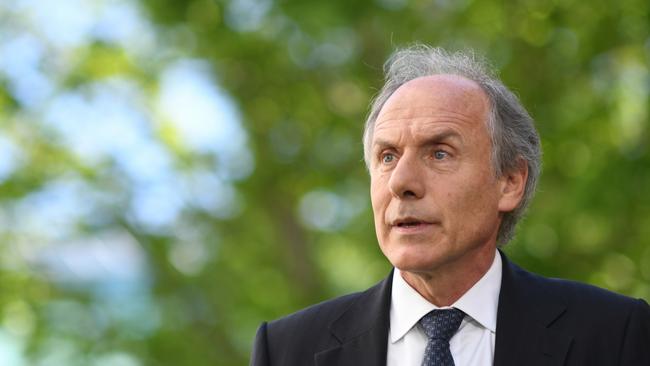Hydrogen pathway is long, but Australia is in the ‘box seat’ to supply the world, Alan Finkel says
The hydrogen opportunity is huge, Dr Alan Finkel says, but the path to a mature hydrogen industry with exports and even ‘swap and go’ retail sales will take many years.

Business
Don't miss out on the headlines from Business. Followed categories will be added to My News.
Australia has about $185bn worth of hydrogen projects in the pipeline, former chief scientist Dr Alan Finkel says, telling the Australian Hydrogen Conference on Tuesday the nation was “in the box seat’’ to be a world leader in the sector.
Dr Finkel, now a special adviser to the federal government on low emissions technology, said it could be argued that humanity is entering the “electric age” and envisioned a future eventually involving “huge production facilities” making hydrogen for industrial customers and potentially “swap and go” hydrogen at the retail level.
He did caution however that the transition would take years, with processes such as steelmaking for example needing to first build pilot plants to prove up the new technology and then roll them out at scale.
“If hydrogen replaces coking coal as the chemical reductant to produce elemental iron, as a precursor to steel, it will take years to develop the pilot plants and many more years to replace or upgrade the thousands of blast furnaces in operation around the world,’’ Dr Finkel said.
“If ammonia made from hydrogen replaces bunker fuel, to power the 90,000 large ships in the international Merchant Marine, it will take years to refine the technology at scale years to developing the bunkering and refuelling infrastructure, then more years to replace the ships that ordinarily have a 30 year operational life.
“And if in some countries ammonia made from hydrogen replaces coal in existing coal fired electricity generators, it will also take us years to prove it works at a 20 per cent penetration level and more years to prove that it works at 100 per cent.’’
Dr Finkel said “all of it is hard, and we have a long way to go’’, but also said that Australia had made great strides since he was first tasked with mapping out the national hydrogen strategy, which he presented to the government in late 2019.
Hydrogen, Dr Finkel said, currently suffered from an imbalance in supply and demand, and while in many ways it was a superior fuel to coal, oil and natural gas, it was not a direct substitute in many use cases.
An easy win on the emissions front, he said, would be to replace the 90 million tonnes of “grey” hydrogen - which is made by stripping the carbon out of natural gas - produced each year to supply industrial processes.
“Doing so would reduce global greenhouse gas emissions by approximately 2 per cent,’’ Dr Finkel said.
“So that would be a big, quick win. But the majority of use cases will take years to develop and scale.’’
READ MORE:Archer cracks quantum tech patents
The path forward for the industry in the next few years, Dr Finkel said, would likely be for integrated operations, such as co-locating renewable energy with industrial operations to produce hydrogen.
“They could be planning an integrated solar, wind and hydrogen project in their steel plant or in their fertiliser plant and they are not necessarily starting with a commitment to a finished solution,’’ Dr Finkel said.
“In steelmaking, hydrogen can be blended initially at low concentrations to substitute a small fraction of the coal or natural gas in the furnace.
“And it can be used in the balance of plant to supply high temperature heat. This can take advantage of cheap, renewable energy in the middle of the day, but more importantly, give those businesses the experience they need in making and using hydrogen.’’
Further along the development pathway, a merchant industry will develop, “and this is where it gets even harder but the opportunity for Australia becomes much larger’’.
“Building huge production facilities solely to produce hydrogen and ammonia for export will require secure, long-term offtake agreements and then as the market matures and diversifies this contract market will very likely be supplemented by the spot market,’’ Dr Finkel said.
“And locally here in Australia I envisage companies setting up retail operations to supply hydrogen for backup systems at hospitals and factories and commercial buildings, as well as refuelling stations in urban areas.
“And this kind of retail hydrogen supply might rely on ‘swap and go’ containers of compressed hydrogen or deliveries of liquefied hydrogen or both.’’
Dr Finkel said the ambition to reach Net Zero was the biggest transformation of our energy systems since our ancestors tamed fire.
“So substantial, that in the naming traditions of the Stone Age, the Iron Age, the Bronze Bronze Age and the Industrial Age, it could be argued that we are entering the Electric Age.
“We need to use all the tools available to us to deploy renewable energy as quickly as possible.
“The key to bringing Net Zero within reach will be to electrify everything. But as you know, there’ll be some instances where electrons are not ideal.
“And for those the world will need hydrogen and ammonia and other derived products.
“Australia can and should play a key role as a reliable and trusted partner in exporting energy at scale, in the form of hydrogen and its derivatives to our friends and neighbours around the world.’’
Originally published as Hydrogen pathway is long, but Australia is in the ‘box seat’ to supply the world, Alan Finkel says



